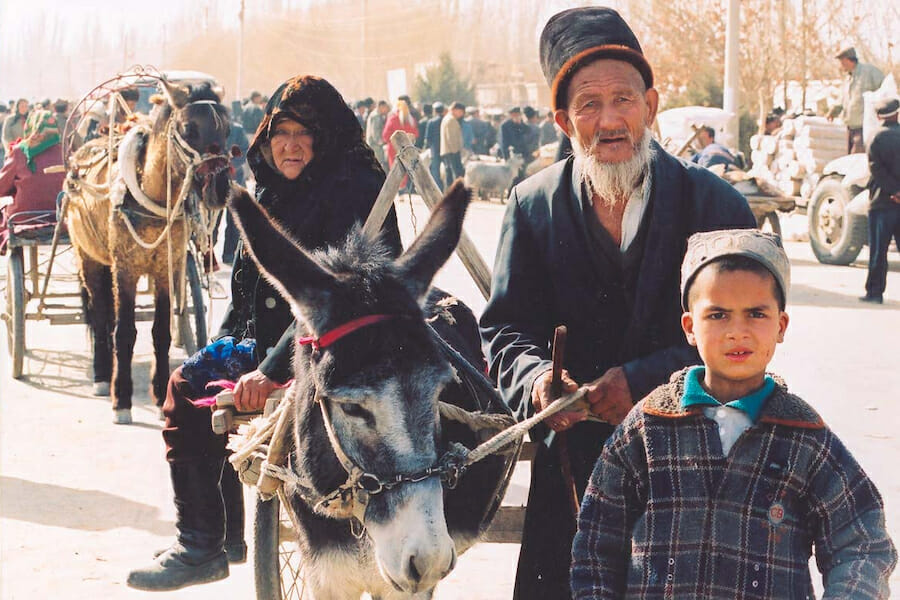
What is a Uyghur ‘Refugee’?
To understand the context of this tweet from Human Rights Watch’s Ken Roth, “Growing number of #Uyghurs trying to flee to Southeast Asia speaks to severe repression in #China,” it might be useful to understand US policy in the region. The United States maintains a refugee channel through Nepal for Tibetans from inside the PRC’s Tibetan Autonomous Region to make their way to Dharmsala.
The PRC is not happy with this arrangement since most of the adults return to Tibet after their visit (the children stay in school in India). The benign explanation is the parents got a shot of religious exaltation by obtaining an audience with the Dalai Lama and go home to go on with their quotidian occupations. The explanation that the PRC government probably leans toward is that these Tibetans are receiving training and resources in Dharmsala to make the PRC occupation of Tibetan regions more difficult.
A similar arrangement for Uyghurs is pretty unlikely since no neighboring countries seem inclined to attract the PRC’s anger by granting refugee Uyghurs an official haven. There are unofficial havens across the Karakorum Pass, but they produce Uyghur terrorists (or, if you prefer, Uyghur freedom fighters; the Uyghurs at Guantanamo were considered combatants, but “non-enemy combatants,” therefore worthy of release since their intention was to target the PRC, not the US) as well as Uyghur activists. As far as I know, the PRC has not yet exercised its regional power prerogative to raid these camps; but the existence of camps and militants inside Pakistan and Afghanistan are the subject of frequent representations to Islamabad and Kabul by the Chinese government and its security services.
In the incident referenced by Mr. Roth, a group of PRC Uyghurs (men, women, & children) were being returned to the PRC from Vietnam after entering illegally (the term of art here is “refoulement,” something that the Nepalese government is not supposed to do with Tibetan refugees); the men apparently seized some weapons from the Vietnamese border guard. Two guards and five Uyghur refugees were killed in the ensuing fracas.
This is unlikely to increase the enthusiasm of Vietnam for providing the refuge Roth is proposing. Nor is the fact that the perpetrators of the knife attack that killed 27 in Kunming were apparently trying to exit the country thataway before they returned to Kunming for their rampage (the local PSB said they were trying to leave the country through Guangdong Province, which appears unlikely; they may have been trying to double back through Guangxi to Vietnam).
Given this context, and the continued acquiescence of the Obama administration to the “terrorist” designation for Uyghur separatists (granted, apparently with some good reason, by President George W. Bush), it seems unlikely that any government will throw itself behind Mr. Roth’s proposal.
Below is an excerpt from a piece I wrote on the Tibetan refugee arrangement for Asia Times in 2011 (the full piece can be read here): “Nepal is caught in a tug-of-war between India and China that threatens to tear it apart. The big picture is dominated by the rivalry of Asia’s two great rising powers, but how and why that rivalry plays out in Nepal has a lot to do with the Tibetan issue and China’s anxiety over the potential for increasingly militant Tibetan emigres in Nepal and India to cause problems for Beijing. A potentially exacerbating factor is the so-called ‘gentleman’s agreement’ that has informally governed the treatment of Tibetan refugees within Nepal for over a decade.”
A WikiLeaks 2010 cable from the US Embassy in New Delhi provides the basis for some intriguing speculation as to the higher (transit refugee) and lower (resident refugee) priorities of the West’s Tibet policy. Over half of the Tibetans arriving in Dharamsala cannot, by any interpretation, be classified as genuine refugees. Why? Because after they escape from Tibet…they go back to Tibet: “XXXXXXXXXXXX [source blanked out in the cable] told PolOff on February 4 that an average of 2,500 to 3,500 refugees from Tibet typically arrive in Dharamsala each year, with most returning to Tibet after receiving an audience with the Dalai Lama. XXXXXXXXXXXX confirmed that from 1980 to November 2009 87,096 refugees were processed by the Dharamsala Reception Center (RC) and that 46,620 returned to Tibet after a short pilgrimage in India. Most of those who do stay in India are children who then attend schools run by Tibetan Children’s Villages.”
That this reverse flow exists passes through Nepal is documented by the exasperated attempt of the Nepalese government to extract fines and fees from the ostensibly impoverished transit refugees they detain while passing through Nepal on their way back to Tibet, as the Tibet Justice Center’s 2002 report notes: “In late 2000, the government detained 19 Tibetans for this reason, charging them with high fines and imprisoning them for inability to pay. On the basis of this “precedent,” in August 2001, the government detained several other Tibetans seeking to return to Tibet after visiting India and assessed fines – totaling several thousand dollars, comprised of visa fees, late visa fees, and fines for each day of alleged illegal residence – on the presumption that these Tibetans had been resident in Nepal illegally for the duration of their visit to India. Because none of the Tibetans could afford to pay, the Nepalese Department of Immigration imprisoned them.”
This amazing exercise in religious tourism is, one would expect, rather suspicious to the Chinese government. Tens of thousands of Tibetans spend thousands of dollars apiece to smugglers, risk their lives crossing the Himalayas, endure the hostile ministrations of the Nepalese police, make it to Dharamsala, receive the Dalai Lama’s blessing – and then run the same gauntlet of danger, abuse, and expense in reverse to return to the well-advertised living hell of the Tibetan Autonomous Region. Only the children stay, to be educated in Dharamsala.
The intense Chinese interest in assembling detailed dossiers on the nine detainees in April 2010 was perhaps related to a desire to be able to identify them as anti-China activists inside Tibet for possible extradition requests. However, it does not appear likely that Nepal will agree to extradite Tibetan refugees back to the TAR in the near future. It would also not appear to be a priority to document who was leaving Tibet permanently to join the emigre community railing, for now impotently, against the PRC.
It appears most likely that Chinese security wanted to know exactly who the nine detainees were because many of them were expected to return to Tibet after a visit to Dharamsala. Plans to return via Nepal – and the need to prevent unfriendly security services from acquiring their true identities – probably also explains why the detainees engage in the “common practice” of providing false identities to the Department of Immigration.
A 2009 profile of refugees in Dharamsala in the Tibet Post International, while describing the mistreatment suffered from the TAR and the hardships endured along the route, also touched on the motivations of some refugees, and why the people leaving Tibet are assumed to be probable returnees and a threat to Chinese rule: “Topjor’s cot is next to 32-year-old Tenpa Dhargye, who arrived from Tibet three days ago. This is his second time in India, in 2000 he came for the first time and upon his return to Tibet was caught carrying political [sic], documents for which he received a four year and 10-month prison sentence.” The author also interviewed four 15-year old boys who made the arduous trek out of Tibet, reporting “They all plan to return to Tibet at some point in the future.”
The director of the reception center roughly confirmed the situation described in the cable disclosed by WikiLeaks, telling the Tibet Post, “Every year 300-400 refugees return to Tibet from India, but this too is dangerous, and the number changes based on the political situation inside Tibet and the security on the border area.” The gentleman’s agreement provides a humanitarian service by providing a path to freedom for Tibetans who find it impossible to continue to live under Chinese rule, and for young people seeking education and environment more in keeping with their Tibetan identity than what they can get in the TAR.
But a majority of the so-called “refugees” use the facility to pay brief visits to Dharamsala to obtain the blessing of the Dalai Lama before returning to the TAR; of these returnees, an unknown number are activists whose motives and mission for making the round trip are no doubt the subject of the most unfavorable speculation by Chinese security services. In the most generous interpretation, the United States supports the Nepalese facility so that every year a few hundred Tibetans from the TAR are able to achieve direct contact with their revered leader.
In the worst case, China could envisage the Nepal conduit as a conveyor belt for activists transporting information, advice, and money between Dharamsala and Tibet – and delivering Tibetan youth for indoctrination in Dharamsala – a mechanism knowingly enabled by the United States through its diplomatic and financial support of the UNHCR operation in Nepal, and through its direct and intense pressure on the Nepalese government to protect the anonymity of these peripatetic refugees from attempts by China’s security apparatus to learn their identities.
The truth is perhaps somewhere in between, more towards the humanitarian end of the spectrum, since the Indian government is serious about discouraging anti-PRC activities by the Tibetan exile community within its borders.

